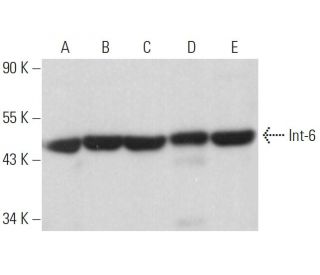
Int-6 Antibody (A-11): sc-133251
- Int-6 Antibody (A-11) is a mouse monoclonal IgG1 κ Int-6 antibody provided at 200 µg/ml
- raised against amino acids 246-445 mapping at the C-terminus of Int-6 of human origin
- Int-6 Antibody (A-11) is recommended for detection of Int-6 of mouse, rat and human origin by WB, IP, IF, IHC(P) and ELISA; also reactive with additional species, including and equine, canine and porcine
- Anti-Int-6 Antibody (A-11) is available conjugated to agarose for IP; HRP for WB, IHC(P) and ELISA; and to either phycoerythrin or FITC for IF, IHC(P) and FCM
- also available conjugated to Alexa Fluor® 488, Alexa Fluor® 546, Alexa Fluor® 594 or Alexa Fluor® 647 for WB (RGB), IF, IHC(P) and FCM, and for use with RGB fluorescent imaging systems, such as iBright™ FL1000, FluorChem™, Typhoon, Azure and other comparable systems
- also available conjugated to Alexa Fluor® 680 or Alexa Fluor® 790 for WB (NIR), IF and FCM; for use with Near-Infrared (NIR) detection systems, such as LI-COR®Odyssey®, iBright™ FL1000, FluorChem™, Typhoon, Azure and other comparable systems
- m-IgG Fc BP-HRP and m-IgG1 BP-HRP are the preferred secondary detection reagents for Int-6 Antibody (A-11) for WB and IHC(P) applications. These reagents are now offered in bundles with Int-6 Antibody (A-11) (see ordering information below).
QUICK LINKS
SEE ALSO...
Int-6 Antibody (A-11) is a mouse monoclonal IgG1 kappa light chain antibody that detects Int-6 of mouse, rat, and human origin by western blotting (WB), immunoprecipitation (IP), immunofluorescence (IF), immunohistochemistry, and enzyme-linked immunosorbent assay (ELISA). Int-6 (A-11) antibody is available in both non-conjugated and various conjugated forms, including agarose, horseradish peroxidase (HRP), phycoerythrin (PE), fluorescein isothiocyanate (FITC), and multiple Alexa Fluor® conjugates. Int-6, also known as eIF3e, eIF3-p46, and eIF3-p48, plays a crucial role in regulating translation and protein degradation by interacting with three key complexes: the eukaryotic translation initiation factor 3 (eIF3), the proteasome regulatory lid, and the constitutive photomorphogenesis 9 signalosome. eIF3 is essential for the assembly of 40S ribosomal subunits on mRNA, which is vital for the initiation of protein synthesis. Notably, Int-6 is a site of integration for the mouse mammary tumor virus (MMTV) in murine tumors, highlighting a potential role in oncogenesis. Studies have shown that reducing Int-6 expression through RNA interference in HeLa cells can disrupt mitosis, leading to defects in spindle formation, chromosome segregation, and cytokinesis, which are associated with the inhibition of cyclin B-Cdk1 kinase activity due to a prolonged inhibitory phosphorylated state of Cdk1. This underscores Int-6′s importance in maintaining proper cell cycle progression and potential implications in cancer research.
Alexa Fluor® is a trademark of Molecular Probes Inc., OR., USA
LI-COR® and Odyssey® are registered trademarks of LI-COR Biosciences
Int-6 Antibody (A-11) References:
- Characterization of the interaction between the interferon-induced protein P56 and the Int6 protein encoded by a locus of insertion of the mouse mammary tumor virus. | Guo, J. and Sen, GC. 2000. J Virol. 74: 1892-9. PMID: 10644362
- Evidence for the transforming activity of a truncated Int6 gene, in vitro. | Rasmussen, SB., et al. 2001. Oncogene. 20: 5291-301. PMID: 11536042
- The human protein HSPC021 interacts with Int-6 and is associated with eukaryotic translation initiation factor 3. | Morris-Desbois, C., et al. 2001. J Biol Chem. 276: 45988-95. PMID: 11590142
- INT6--a link between the proteasome and tumorigenesis. | Yen, HC. and Chang, EC. 2003. Cell Cycle. 2: 81-3. PMID: 12695651
- Protein homeostasis: a degrading role for Int6/eIF3e. | von Arnim, AG. and Chamovitz, DA. 2003. Curr Biol. 13: R323-5. PMID: 12699646
- Cell cycle-related variation in subcellular localization of eIF3e/INT6 in human fibroblasts. | Watkins, SJ. and Norbury, CJ. 2004. Cell Prolif. 37: 149-60. PMID: 15030549
- Silencing of human Int-6 impairs mitosis progression and inhibits cyclin B-Cdk1 activation. | Morris, C. and Jalinot, P. 2005. Oncogene. 24: 1203-11. PMID: 15558017
- Characterization of the INT6 mammary tumor gene product. | Diella, F., et al. 1997. DNA Cell Biol. 16: 839-47. PMID: 9260927
- The translation initiation factor eIF3-p48 subunit is encoded by int-6, a site of frequent integration by the mouse mammary tumor virus genome. | Asano, K., et al. 1997. J Biol Chem. 272: 23477-80. PMID: 9295280
Ordering Information
| Product Name | Catalog # | UNIT | Price | Qty | FAVORITES | |
Int-6 Antibody (A-11) | sc-133251 | 200 µg/ml | $316.00 | |||
Int-6 Antibody (A-11): m-IgG Fc BP-HRP Bundle | sc-527097 | 200 µg Ab; 10 µg BP | $354.00 | |||
Int-6 Antibody (A-11): m-IgG1 BP-HRP Bundle | sc-532470 | 200 µg Ab; 20 µg BP | $354.00 | |||
Int-6 Antibody (A-11) AC | sc-133251 AC | 500 µg/ml, 25% agarose | $416.00 | |||
Int-6 Antibody (A-11) HRP | sc-133251 HRP | 200 µg/ml | $316.00 | |||
Int-6 Antibody (A-11) FITC | sc-133251 FITC | 200 µg/ml | $330.00 | |||
Int-6 Antibody (A-11) PE | sc-133251 PE | 200 µg/ml | $343.00 | |||
Int-6 Antibody (A-11) Alexa Fluor® 488 | sc-133251 AF488 | 200 µg/ml | $357.00 | |||
Int-6 Antibody (A-11) Alexa Fluor® 546 | sc-133251 AF546 | 200 µg/ml | $357.00 | |||
Int-6 Antibody (A-11) Alexa Fluor® 594 | sc-133251 AF594 | 200 µg/ml | $357.00 | |||
Int-6 Antibody (A-11) Alexa Fluor® 647 | sc-133251 AF647 | 200 µg/ml | $357.00 | |||
Int-6 Antibody (A-11) Alexa Fluor® 680 | sc-133251 AF680 | 200 µg/ml | $357.00 | |||
Int-6 Antibody (A-11) Alexa Fluor® 790 | sc-133251 AF790 | 200 µg/ml | $357.00 |
